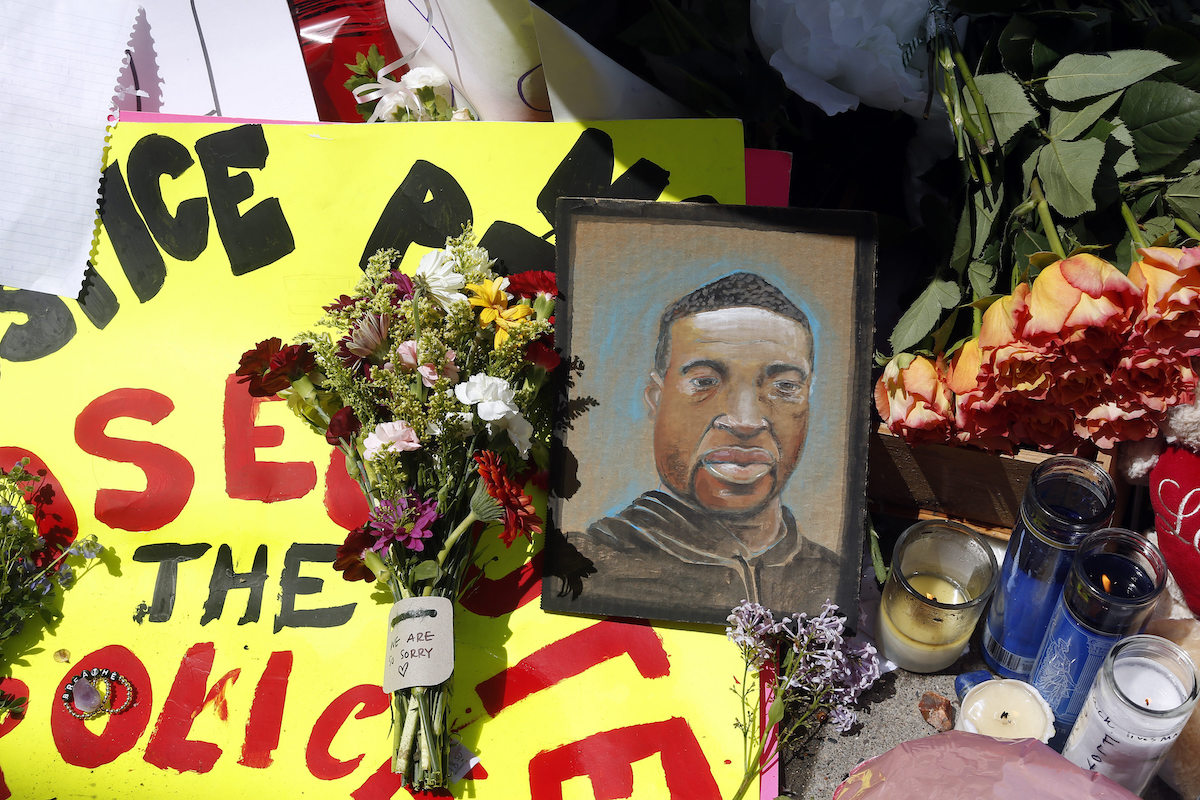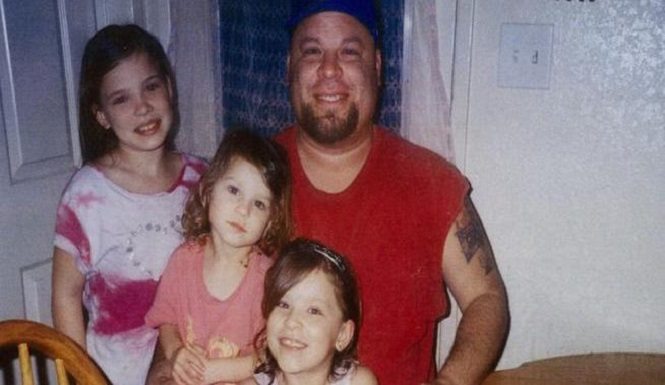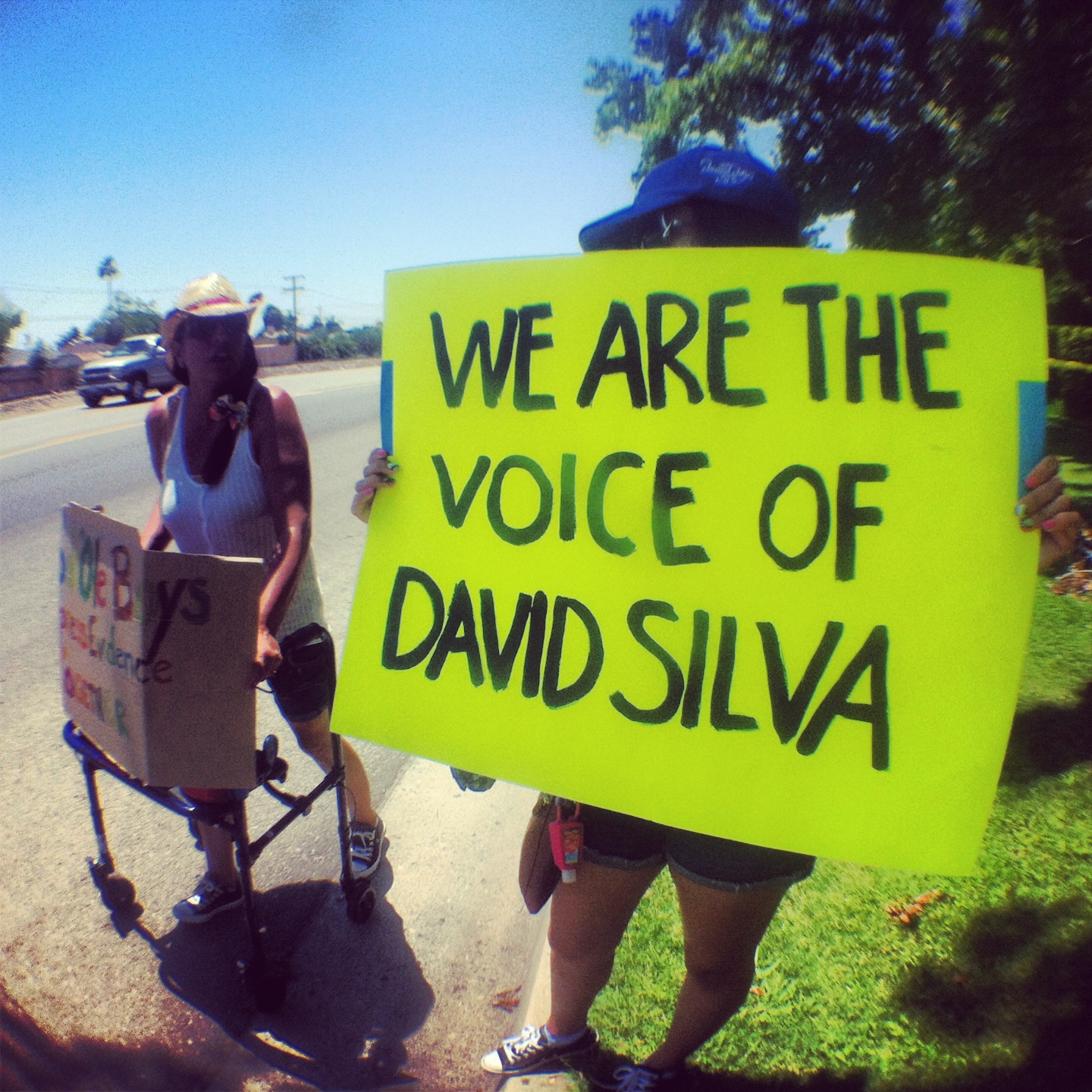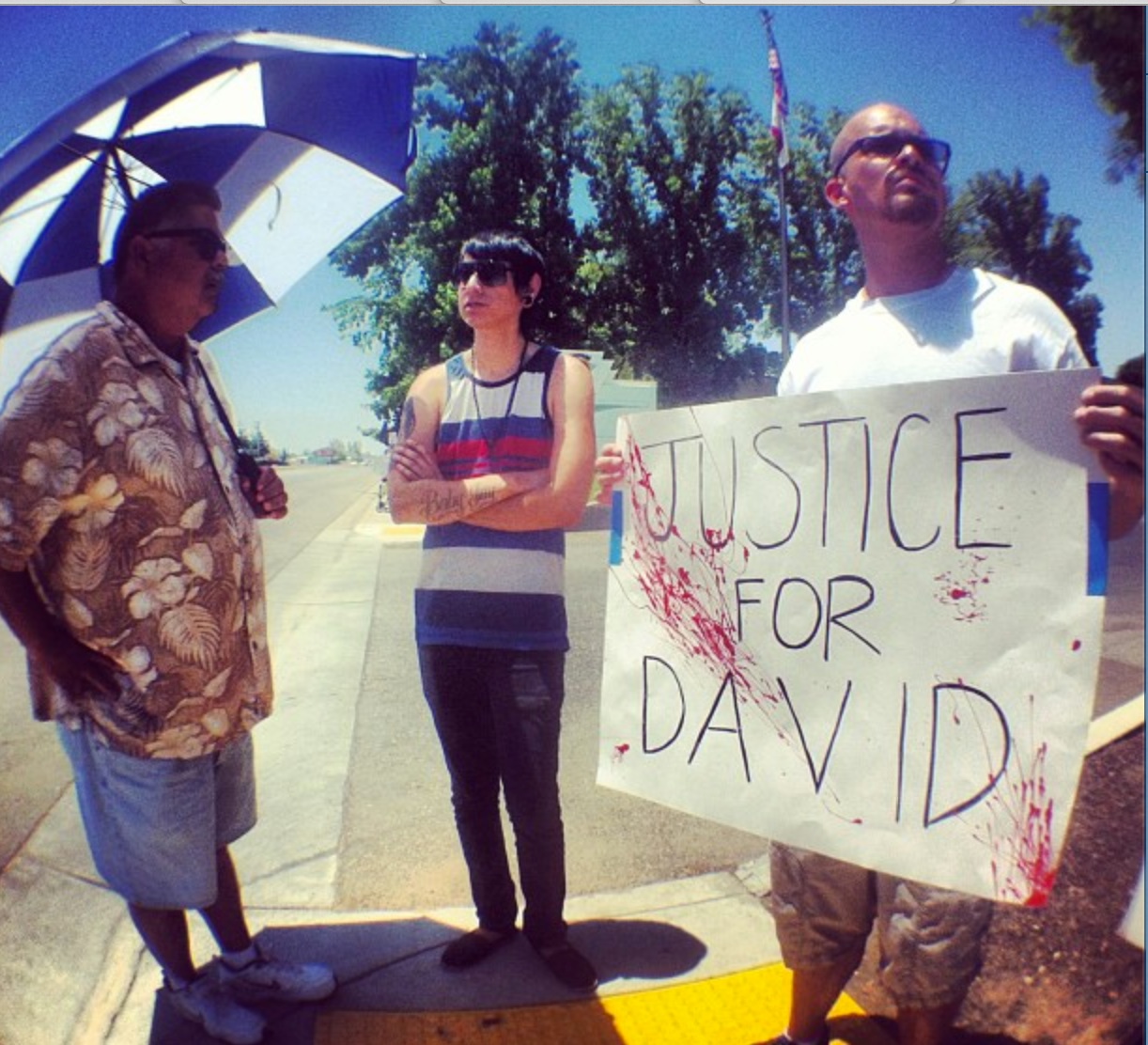

A chain portrait of George Floyd is part of the memorial for him, Wednesday, May 27, 2020 in Minneapolis. (AP Photo/Jim Mone)
Both men call out, cry into the same America, one in the darkness, one in the light.
One fresh on our minds. George Floyd dying in daylight on a cold, hard Minneapolis street. A fast-thinking teen’s recording provides the initial spark—a fire that sets all of America into motion, flames reflecting past civil strife, beatings, lynchings, lines of riot police, singing crowds, and a sea of signs demanding a new America.
Floyd’s cry echoes through radios and televisions, smart phones, artwork, cables, thoughts, dreams. This time recently on CNN. The show is “I Can’t Breathe: Black Men Living and Dying in America.” Don Lemon looks like he hasn’t slept in a week. He whispers for us to watch.
George calls for his mother. He groans as if his own car is atop his neck bones, let alone the knee on his neck, knees everywhere on his body, crushing down, his arms twisted. This over a twenty-dollar bill, in an America where twenty counterfeit bucks won’t get you much. Neither will Trump’s pandemic economic stimulus, which left millions struggling, wondering if rent and food money will drop through the bomb bay doors of some magical red-white-and-blue Space Force vessel.
This TV show rages. Spike Lee, like an entertainment sage, wise and vocal, greying in his 1619 T-shirt, as if stepping from a “Do the Right Thing” time portal, shares echoes of Radio Raheem’s untimely end. Don Lemon whispers again that we must witness the violence.
We see George again. Eric Garner this time too. And Radio Raheem. Truth in fiction flashes lighting bolts into our guts as Raheem is taken down and destroyed. My stomach turns to knots. My mind wanders. I think Bill Nunn has still left us too soon though he put 62 years on this earth. Raheem, grey haired. No more. Garner can’t breath. Floyd can’t breathe. I can’t breathe. I turn off the TV.
But I can’t turn this off. This feeling. These thoughts now turned to Floyd’s autopsy. The opening of his every body cavity rings familiar. A cat and mouse courthouse game where cities and coroners and police departments downplay events, causes of death, reality recorded on film for us to witness, the images that old man Spike says Americans are sick and tired of. We’ve seen it before: discredited victims. It’s this heartless lawyer-vision, cruelly strategic lawyer-speak, a medical examiner possibly in on the game. Like some kind of shitty version of an already pulpy Grisham novel—it comes to us in the form of a released statement, downplaying events, thinking ahead, sharp eyes farther down the legal road than the rest of us, who are still stuck in Floyd’s past, in our bloody present, as we play those eight-odd minutes of torture, watching him gasp for breath, over and over in our frightened minds.
The City of Minneapolis is already looking to this playing out in front of a jury. Fingers are pointed, not at the arresting officers, knees covered with the DNA of a dying man, but at the ghost of George. When this is all over they might want you to think he’s hanged himself over the Minneapolis courthouse.
The Hennepin County Medical Examiner finds Floyd’s cause of death is the “combined effects of Mr. Floyd’s being restrained by police, underlying health conditions and any potential intoxicants in his system.”
The report does not indicate asphyxia or strangulation. Powerful lawyers and city leaders want to control the narrative. They want to deflect, minimize guilt and pin the death on Floyd himself.
On Monday, George Floyd’s family released the results of an independent autopsy. The report claimed Floyd’s cause of death as “asphyxiation from sustained pressure was the cause.” It includes “neck and back compression that led to a lack of blood flow to the brain.”
A Similar Case
Floyd’s initial autopsy rings familiar to that of David Sal Silva, 33, who died at the hands of Bakersfield, California law enforcement on a dark street corner across from a hospital.


Not only were Floyd and Silva victims of brutality, they both endured eight minutes of hell. Eight minutes of torture at the hands of the police. Both deaths were captured on video.
Silva had fallen asleep in the early morning hours of May, 8, 2013, after being turned away from an emergency room while trying to seek help for an addiction. He stumbled across the street and fell asleep
The hospital loomed over him: a symbol of annihilation that should have been a beacon of hope. Instead, it was like a dark lighthouse that beckons you toward rocky shores, only to turns out the lights as you navigate its dangerous shoals.
Similar to Floyd’s initial autopsy results, Silva’s death was pinned on him and ruled accidental. Silva received gashes and cuts all over his body, head, face and arms during the eight minutes after he was woken from his slumber on the street corner. In whatever haze he was in, Silva tried to stand up. He was attacked over and over. He fought for his life against teeth and batons. He was blamed for his own death partly because of an underlying heart condition.
City of Trumpism and Bloodshed
An eerie paranoia began in Bakersfield before the first George Floyd protest last Friday. That afternoon social media turned into a flame of paranoia, according to a Facebook post by a Bakersfield Californian reporter. There would be violence because of the protesters, the paranoid claimed. Downtown must evacuate, they cried. The reporter cried out for logic, noting there had been many rallies supporting unarmed victims who died at the hands of local law enforcement. None of those rallies had been violent. I’d been to one about six years ago in support of David Sal Silva. My only fear was what officers might do to me.


(Photo by Nick Belardes)
Dark, noirish, Bakersfield is under a constant bubble of refinery waste, dust, smoke and airborne pesticides. Already with high unemployment, out-of-control pre-pandemic opioid addiction and staggering asthma rates, it’s filled with its share of seedy lawmen, paranoid right-wing churchgoers, redneck oil culture—and though over fifty percent Latino—harbors a hatred and intolerance of farm workers, liberals, Chicanos, Blacks and other people of color. When California recently eradicated many of its Confederate monuments and school names, Bakersfield retained its bleak Southern imagery in the form of Confederate-inspired street and school names. It’s a season of True Detective just waiting to be written.
You won’t see this on CNN or read it in the New York Times: snipers on the downtown Bakersfield courthouse buildings during the George Floyd protest, throngs of multiracial protesters, and a car crashing through them (captured on video) allegedly attempting to run down protesters. He injured a 15-year-old girl and was arrested for attempted murder.
I’m not surprised. Bakersfield is both a city of bloodshed and a microcosm of Trumpism. Ruled by conservatism, the city is controlled by fast-talking Republican politicians, and a sheriff who wants the city in his dirty grasp. Its most prominent figure, House Minority Leader Kevin McCarthy, well known as a fixer for President Trump, is an awkward, bumbling speaker, an attempted political hit man of Hillary Clinton over a politically motivated and botched Benghazi inquiry, and one of Trump’s most dependable mouthpieces during his recent impeachment.
McCarthy’s Twitter says it all. McCarthy and Trump appear to mock us as they point to the camera. A sign of power. One a fixer, one America’s symbol of bullying. They can laugh at you even if you’re crying because of them.
Trump calls McCarthy “My Kevin,” and “The great Kevin McCarthy.” McCarthy’s in Trump’s back pocket like a stale gumball that the president chews on once in a while when wanting to show off just how much hot air he can blow into the man. Why else call McCarthy “My Kevin” other than as a sign of ownership, that this Bakersfield politician belongs to the president and him alone? No wonder U.S. Rep. Justin Amash of Michigan tweeted, “Kevin McCarthy again displays his unique brand of incompetence and dishonesty,” after the minority leader made himself a buffoon during a 2019 “60 Minutes” interview trying to defend the President.
Don’t even get me started on the topic of immigration reform, the May Day rallies, the marches that ended at McCarthy’s office where citizens asking honest questions have been arrested. This brutal landscape within conservative Central California is McCarthy’s landscape, where police brutality, though ignored and unchecked by him, has been at the epicenter of criticism of the area’s police and sheriff’s departments.
Ongoing Reports of Bakersfield Police Violence
In 2015, the U.K. Guardian released a series of reports finding America’s deadliest police were comprised of two law enforcement agencies in Bakersfield. Journalists uncovered a culture of brutality, corruption and secrecy.
The American Civil Liberties Union (ACLU) of California followed up with their discoveries of law enforcement in Kern County using excessive force that deprived citizens of constitutional rights. In 2017 the ACLU of Southern California published a report called PATTERNS & PRACTICES OF POLICE EXCESSIVE FORCE IN KERN COUNTY FINDINGS & RECOMMENDATIONS. Their findings against the Kern County Sheriff’s Office and Bakersfield Police Department include:
… patterns and practices that violate civil rights. KCSO and BPD officers have engaged in patterns of excessive force—including shooting and beating to death unarmed individuals and deploying canines to attack and injure—as well as a practice of filing intimidating or retaliatory criminal charges against individuals they subject to excessive force.


David Silva’s brother at June 8, 2013 demonstration in Bakersfield. (Phoyo by Nicholas Belardes)
The report also indicates canines were deployed to intimidate and injure, not to avoid using greater force. The canines were used to escalate attacks that included weapons like batons, Tasers and guns. The report mentions Silva specifically in regards to canine attacks:
KCSO and BPD officers deploy canines not only to locate suspects at large or in hiding, but to intimidate and injure people already in their presence—including people who are unarmed. A KCSO deputy had already located David Sal Silva, who was not armed, fleeing or even mobile, when he initiated the canine attack… leading up to David Sal Silva’s death, KCSO deputies released a canine to bite him, then struck him across the head with their batons in response to his attempt to stop the canine attack, which by that point had continued for several minutes.
Chris Silva, brother of victim David Sal Silva, released an email on Sunday from the U.S. Department of Justice (DOJ). It gives evidence that both Bakersfield law enforcement departments are still under investigation for excessive brutality. The DOJ refused to comment on the status, thus indicating by default the existence of an investigation.
In the meantime, commonalities between Silva and Floyd’s deaths and autopsy findings reflect an ongoing culture of violence and victim blaming that has been escalating against people of color during the Trump presidency, one in which citizens continue to wonder whether police reform or more brutality is on the way.
***
Nicholas Belardes is a California-based writer and former ABC news managing editor. You can find more about his nonfiction and fiction at nicholasbelardes.com. He’s on Twitter @nickbelardes.
Editor’s Note: Seven years ago in 2013, LatinoRebels.com ran a three-part series by Belardes about the in-custody death of David Sal Silva. He added an epilogue to the series in 2014.


